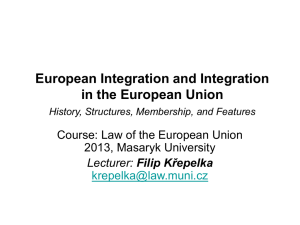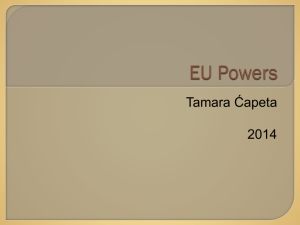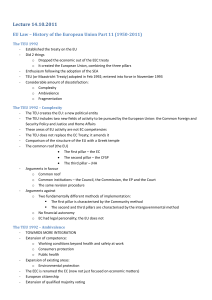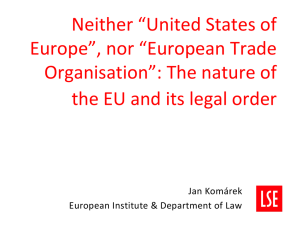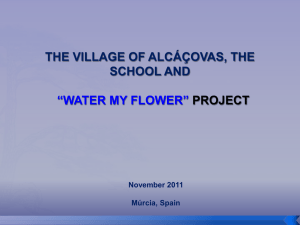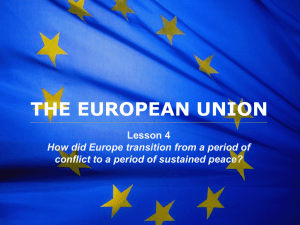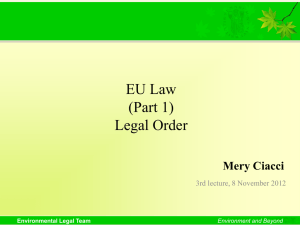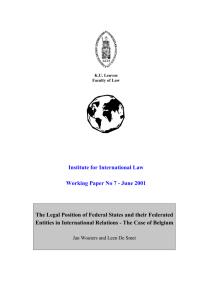EU law 1 - introduction - Unisi.it
advertisement
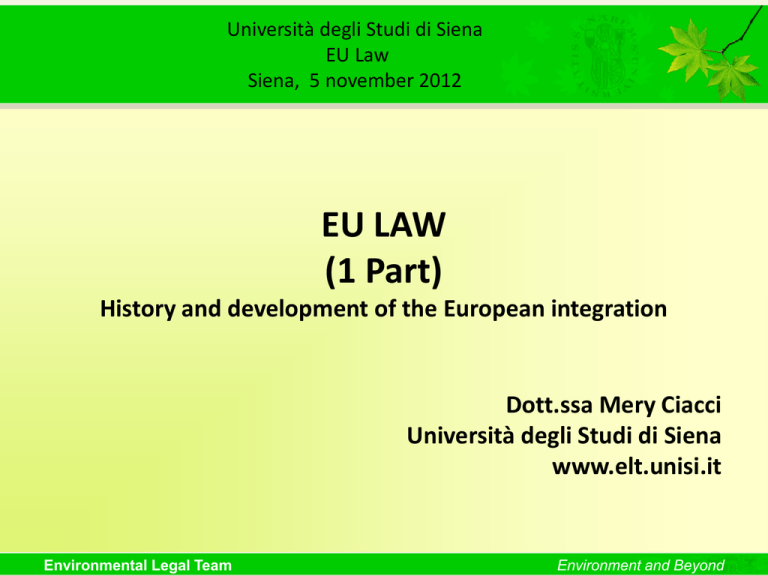
Università degli Studi di Siena EU Law Siena, 5 november 2012 EU LAW (1 Part) History and development of the European integration Dott.ssa Mery Ciacci Università degli Studi di Siena www.elt.unisi.it Environmental Legal Team Environment and Beyond Structure and methodology • Part I: the EU legal order - Introduction to EU law: history and developments of the European integration - Institutions of the Union - The Union’s legal order: principles, legal acts, rulings • - Part II: the common market Four freedoms of movement: goods, workers, services, capital Economic and Monetary Union (EMU) competition law • Seminars Environmental Legal Team Environment and Beyond What is the European Union? Environmental Legal Team Environment and Beyond Elements of International Law • EU as an actor of International law: - International Organization (with legal personality) of regional integration • - The Union as a “sui generis” actor of international law: intergovernmental and supranational features Similarities with federal State (i.e.: division of competences) A political internal and external dimension • EU law as a (self-contained) system of International Law: - concessions of sovereign powers by Member States through the international treaties - Set of independent rules - Institutions - Independent system of adjudication Environmental Legal Team Environment and Beyond What is EU law? • It is the set of principles and rules that regulate the relationship among the Member States of the European Union • It derives from: - international treaties: founding treaties of the 3 communities + following treaties and amendements (primary law) - Legal acts of the EU institutions (secondary law) Environmental Legal Team Environment and Beyond History and evolution of the EU integration • In the aftermath of the 2nd WW: a new model of political cooperation for peace in Europe was desired • Churchill’s speech at the University of Zurich, 1946 • Marshall Plan, 1947 • Schuman’s declaration, 9th may 1950 Environmental Legal Team Environment and Beyond Founding treaties • Treaty of Paris founding the ECCS (European Communitiy of Coal and Steel), Paris 18 April 1951,entered into force in 1952, signed by France, Germany, Italy, Belgium, Luxembourg, Netherlands • Treaty of Rome founding the EEC (European Economic Community), Rome 25 march 1957, entered into force in 1958 • Euratom Treaty, founding the European Community for atomic energy (Euratom), Rome 25 march 1957, entered into force in 1958 Environmental Legal Team Environment and Beyond 3 communities on strategic economic sectors • European Community of Coal and Steel • European Economic Community • European Community for atomic energy Environmental Legal Team Environment and Beyond Institutional asset: 3 distinct communities with Commons institutions • Court of Justice • Assembly Environmental Legal Team Different institutions • ECCS: High Authority, Council of Ministers • EEC: EEC Commission • Euratom: Euratom Commission Environment and Beyond Primary objectives: focus on eonomic growth • To establish a common market, based on free trade principles (i.e.: barriers to trade progressively abolished, a common customs was set up, rules for fair competition were adopted) • To approximate the economic policies of the Member States • To promote harmonious development of economic activities throughout the Community • To increase stability and raise the standard of living • To promote closer relations between the Member States Environmental Legal Team Environment and Beyond Further steps towards integration… • 1957: fusion of executive bodies (Council of Ministers tout court, fusion of the High Authority and the Commission into one Commission) • Still 3 different communities: different attributed competences, different fields of action, but common institutions Environmental Legal Team Environment and Beyond Enlargements • - First round: 1973: Denmark, United Kingdom, Ireland 1981: Greece 1986: Spain and Portugal Environmental Legal Team Environment and Beyond Further steps in the integration process… • 1979: first direct election of the European Parliament • 1986: adoption of the Single European Act - positive integration: broader areas of competences, i.e.: environment, transports, telecommunication • Negative integration: progressively reduction of direct and indirect obstacles to commercial exchanges • Court of Justice: integration fostered through rulings (peculiarity of the European integration) Environmental Legal Team Environment and Beyond Single European Act (SEA) • 60s and 70s: period of stagnation of the European integration process • Need for an institutional reform (to strengthen supranational aspects and diminish the impacts of intergovernmentalism) • SEA (1986): - Little far-reaching institutional reform: enhanced EP’s power in the legislative process (new legislative ‘cooperation’ procedure) - Extension of competences for the EC (social policy, environment, economic and social cohesion, research and technological development) - Further progress in establishing the internal market: a deadline to remove a list of barriers by the 31 January 1992; defined the internal market as ‘an area without internal frontiers in which the free movement of goods, persons, services and capital in ensured’ Environmental Legal Team Environment and Beyond Treaties’evolution • Treaty of Maastricht founding the European Union, 7 February 1992 • Treaty of Amsterdam, 2 October 1997 (entered into force in 1999) • Nice Treaty, 26 February 2001, (entered into force in 2003) • Lisbon Treaty, 13 December 2007, (entered into force in 2009) Environmental Legal Team Environment and Beyond Treaty of Maastricht (TEU) • Created the European Union (legal personality Art. 47 TEU) • Enhancement of the political dimension • Institutional change: the 3-pillars structure • European Citizenship • Extended competences in new areas, i.e.: culture, research and development, etc… • Broader power to the EU Parliament (co-decision) Environmental Legal Team Environment and Beyond The 3-pillar structure 3 PiIlars European Communities (EEC was renamed the EC) CFSP (Common Foreign Security Policy) CFSP Environmental Legal Team JHA/ Police and Judicial Cooperation Justice and Home Affairs, in 2003 was renamed Police and Judicial Cooperation in Criminal Matters (PJC ) Environment and Beyond 1st Pillar: the 3 European Communities • Areas subject to the supranational powers of the Communities • Policies falling under the field of competences of the Communities, as established in the treaties : Free movement of goods, workers, services, capital Agriculture transports Customs Research and development Environment Environmental Legal Team Environment and Beyond 2nd Pillar: the common foreign and security policy • Title V of the TEU • Established a mechanism of intergovernmental cooperation (overcoming the Ad hoc meetings) through which the Members could cooperate to: Strenghten security and maintain peace Promote international cooperation Promote common values, human rights, the respect of the rule of law and democracy • Not an area subject to the supranational methods of decision-making (like the 1° pillar), but sensitive areas where the Members still wished to maintain control on Environmental Legal Team Environment and Beyond 3rd Pillar: JHA/Police and Judicial Cooperation • Title VI of the TEU • Area of intergovernmentalism • Policies such as: Asylum Immigration ‘third country’ nationals Cooperation for the fight to international crimes, illicit trafficking, etc. and various forms of judicial, customs and police cooperation • Establishment of a European Police Office (Europol) for exchanging information and stronger cooperation in judicial matters (Eurojust) • Major role by the Council • Limited powers of the European Court of Justice Environmental Legal Team Environment and Beyond Enlargements • Second round: - 1995: Austria, Finland, Sweden (Norway: negotiated the accession acts, but a national referendum opposed accession) Environmental Legal Team Environment and Beyond Treaty of Amsterdam • • • • Amending the TEC and TEU (new numeration) Fostered integration through widening the areas of competences Consolidated role of the EP in the decision-making process Introduced a new Title IV into the TEC, on Visas, asylum, immigration and other policies related to free movement of persons (‘communitarization’ of an area falling under the 3rd pillar, now reduced to police and judiciary cooperation in criminal matters) • No real institutional reform • Stronger accent on the protection of human rights and fundamental freedoms Environmental Legal Team Environment and Beyond Treaty of Nice: The Charter of fundamental Rights • Nice Treaty: some changes to institutional structure of the EC (i.e. the weighting of votes in the Council, enhanced the EP’s power by extending the co-decision procedure to new areas) • News: The adoption of a Charter of Fundamental Rights Soft law instrument: a step forward for the legitimacy, identity and human rights commitment of the EU Why the need to strengthen the Human Rights dimension within the EU? The underlying debate between the Constitutional Courts and the ECJ Environmental Legal Team Environment and Beyond Enlargements • Third Round: - 2004: Cyprus, Estonia, Latvia, Lithuania, Malta Poland, Czech Republic, Slovakia, Slovenia, Hungary - 2007: Bulgaria, Romania • Requirements: - The ‘Copenaghen criteria’ set by the European Council in 1993 - To adopt the entire ‘acquis communautaire’ Environmental Legal Team Environment and Beyond Treaty of Lisbon • former project: the European Constitution (failure, political impasse) • 2009: Treaty of Lisbon - the 3 pillars structure disappears - TUE + TFUE (former TEC) + Nice into a single Treaty - Strengthened role of the EU Parliament - Broader Union’s competences • Birth of the European External Action Service (EEAS) Environmental Legal Team Environment and Beyond
